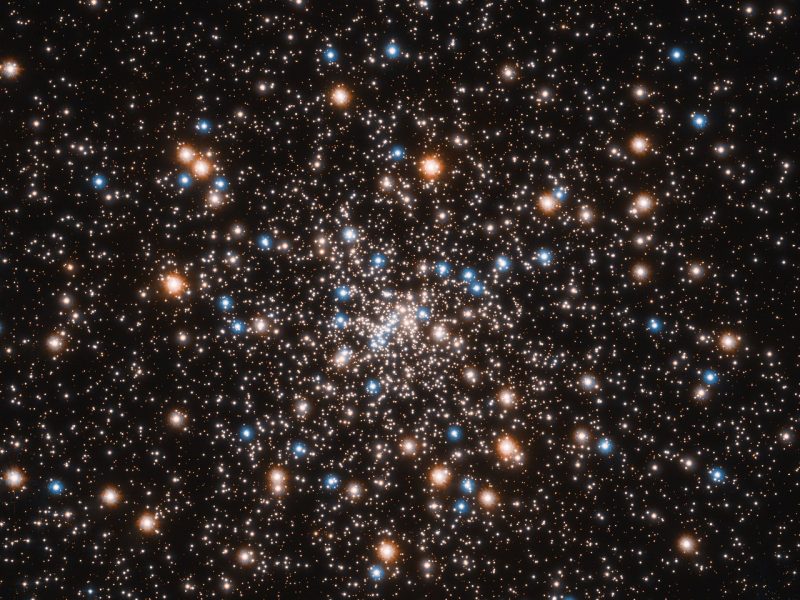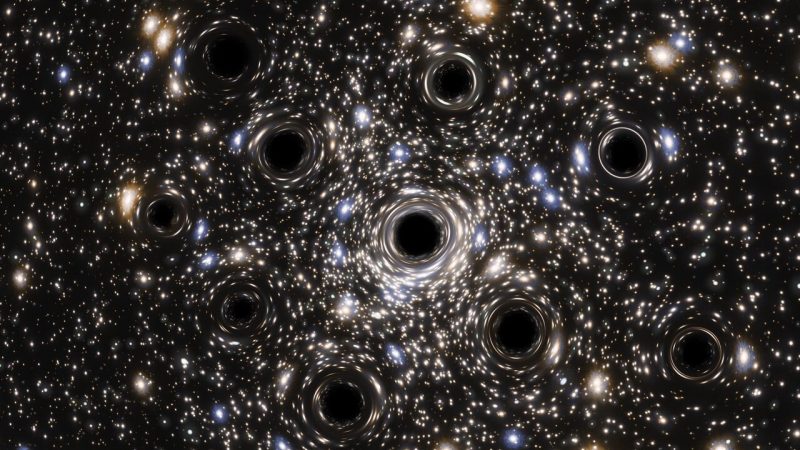
In this episode of Space Sparks, ESA/Hubble summarizes their findings.
Sometimes in science when you set out to find something you had predicted, you instead find something quite different. This was the case recently when astronomers using the Hubble Space Telescope examined the core of a globular cluster, a “ball” of densely packed old stars named NGC 6397, looking for one central intermediate-mass black hole. Instead they unexpectedly found a whole swarm of small black holes, as reported by NASA and ESA on February 11, 2021.
There are two well-established types of black holes: the stellar-mass black hole that is formed when a large star runs out of fuel and collapses and weighs just a few times the mass of our sun, and the supermassive black hole that is believed to exist in the center of every large galaxy and contains the mass of many millions of stars. Apart from these two types, astronomers believe that a middle-of-the-road type of black hole should also exist – the intermediate-mass black hole, with a mass of 100 to 100,000 times the mass of our sun – and there are several candidates for these but only a few confirmed cases.
These researchers’ analysis of data from the Hubble Space Telescope and Gaia Space Observatory on this globular cluster did not provide the evidence of a medium-sized black hole at its core that the astronomers were looking for. Instead, they made the very first detection of a collection of black holes at the center of a globular cluster.

The globular cluster NGC 6397, containing hundreds of thousands of stars, was imaged by the Hubble Space Telescope. The cluster’s blue stars are hotter and near the end of their lives, while orange ones are expanded red giant stars. The white stars include stars that are similar to our sun. Image via NASA/ ESA/ T. Brown and S. Casertano (STScI).
Astronomers targeted this particular globular cluster, NGC 6397, because at 7,800 light-years away, it’s one of the closest globular clusters to Earth. More importantly, scientists think that a globular cluster is an ideal place to find medium-sized black holes because of the dense collection of stars at their cores.
Globular clusters are large spherical collections of stars that orbit on the peripheries of galaxies. The clusters are ancient, sometimes nearly as old as the universe itself. A core-collapsed globular cluster, such as NGC 6397, is one that is old enough that the more massive stars have gravitated toward the center of the cluster, and the younger stars have traveled out towards its outskirts. This gives the globular cluster a very dense nucleus.
Because these black holes are not possible to directly observe, the astronomers measured how the stars in the cluster move – their velocities – to find the distribution of mass in the cluster. The locations where stars were found to be moving faster are areas where more mass is concentrated. Yet the distribution of these stars was not confined to one point-like central location in the core, as would be expected from the presence of an intermediate-sized black hole. Instead, the mass appears to be spread more randomly, extending to a few percent of the size of the cluster.
Therefore, based on stellar evolution, the astronomers concluded that the remains of stars in the form of stellar-mass black holes are populating the inner regions of the globular cluster. NGC 6397 could host more than 20 of these, the “lightest” kind of black holes.

This artist’s concept shows the concentration of black holes at the center of globular cluster NGC 6397. In reality, the black holes are far too small for direct observation by any existing telescopes. This globular cluster may contain more than 20 black holes. Image via ESA/ Hubble/ N. Bartmann.
Like many scientific discoveries, the finding of a concentration of black holes in a globular cluster raises more questions, with a key one being: could the merger of these black holes pressed into close quarters result in gravitational waves? Maybe scientists will find out if black holes crashing together produce the ripples in gravity recently seen by some instruments, and maybe they’ll discover something they didn’t even plan on.
Bottom line: Astronomers went looking for one medium-sized black hole in the center of a globular cluster and instead found a whole swarm of smaller black holes.
Source: Does NGC 6397 contain an intermediate-mass black hole or a more diffuse inner subcluster?
The 2021 lunar calendars are here. Order yours before they’re gone!
from EarthSky https://ift.tt/3aEh2PE

In this episode of Space Sparks, ESA/Hubble summarizes their findings.
Sometimes in science when you set out to find something you had predicted, you instead find something quite different. This was the case recently when astronomers using the Hubble Space Telescope examined the core of a globular cluster, a “ball” of densely packed old stars named NGC 6397, looking for one central intermediate-mass black hole. Instead they unexpectedly found a whole swarm of small black holes, as reported by NASA and ESA on February 11, 2021.
There are two well-established types of black holes: the stellar-mass black hole that is formed when a large star runs out of fuel and collapses and weighs just a few times the mass of our sun, and the supermassive black hole that is believed to exist in the center of every large galaxy and contains the mass of many millions of stars. Apart from these two types, astronomers believe that a middle-of-the-road type of black hole should also exist – the intermediate-mass black hole, with a mass of 100 to 100,000 times the mass of our sun – and there are several candidates for these but only a few confirmed cases.
These researchers’ analysis of data from the Hubble Space Telescope and Gaia Space Observatory on this globular cluster did not provide the evidence of a medium-sized black hole at its core that the astronomers were looking for. Instead, they made the very first detection of a collection of black holes at the center of a globular cluster.

The globular cluster NGC 6397, containing hundreds of thousands of stars, was imaged by the Hubble Space Telescope. The cluster’s blue stars are hotter and near the end of their lives, while orange ones are expanded red giant stars. The white stars include stars that are similar to our sun. Image via NASA/ ESA/ T. Brown and S. Casertano (STScI).
Astronomers targeted this particular globular cluster, NGC 6397, because at 7,800 light-years away, it’s one of the closest globular clusters to Earth. More importantly, scientists think that a globular cluster is an ideal place to find medium-sized black holes because of the dense collection of stars at their cores.
Globular clusters are large spherical collections of stars that orbit on the peripheries of galaxies. The clusters are ancient, sometimes nearly as old as the universe itself. A core-collapsed globular cluster, such as NGC 6397, is one that is old enough that the more massive stars have gravitated toward the center of the cluster, and the younger stars have traveled out towards its outskirts. This gives the globular cluster a very dense nucleus.
Because these black holes are not possible to directly observe, the astronomers measured how the stars in the cluster move – their velocities – to find the distribution of mass in the cluster. The locations where stars were found to be moving faster are areas where more mass is concentrated. Yet the distribution of these stars was not confined to one point-like central location in the core, as would be expected from the presence of an intermediate-sized black hole. Instead, the mass appears to be spread more randomly, extending to a few percent of the size of the cluster.
Therefore, based on stellar evolution, the astronomers concluded that the remains of stars in the form of stellar-mass black holes are populating the inner regions of the globular cluster. NGC 6397 could host more than 20 of these, the “lightest” kind of black holes.

This artist’s concept shows the concentration of black holes at the center of globular cluster NGC 6397. In reality, the black holes are far too small for direct observation by any existing telescopes. This globular cluster may contain more than 20 black holes. Image via ESA/ Hubble/ N. Bartmann.
Like many scientific discoveries, the finding of a concentration of black holes in a globular cluster raises more questions, with a key one being: could the merger of these black holes pressed into close quarters result in gravitational waves? Maybe scientists will find out if black holes crashing together produce the ripples in gravity recently seen by some instruments, and maybe they’ll discover something they didn’t even plan on.
Bottom line: Astronomers went looking for one medium-sized black hole in the center of a globular cluster and instead found a whole swarm of smaller black holes.
Source: Does NGC 6397 contain an intermediate-mass black hole or a more diffuse inner subcluster?
The 2021 lunar calendars are here. Order yours before they’re gone!
from EarthSky https://ift.tt/3aEh2PE

Aucun commentaire:
Enregistrer un commentaire